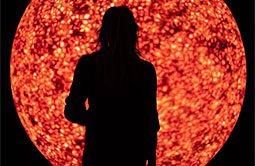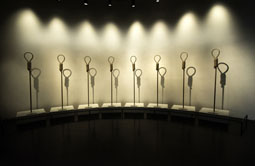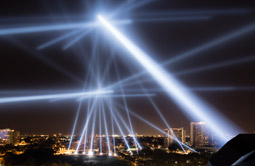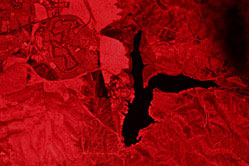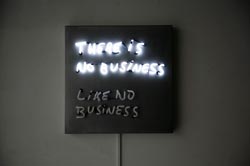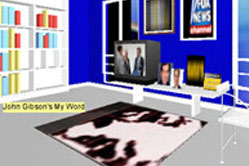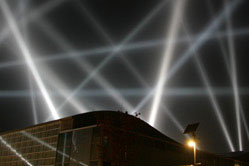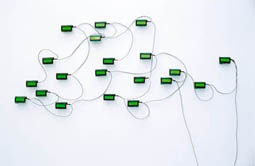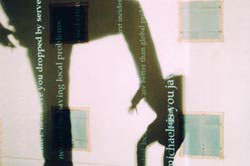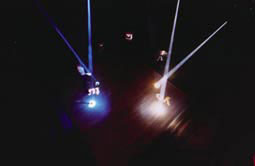Recurrent Anaximander
2020
“Recurrent Anaximander” is a generative animation running on a custom-made 400,000 pixel circular display. The piece features a solar simulation made with Reaction Diffusion, Navier Stokes, Voronoi and Perlin Noise algorithms, running on top of a Solar Dynamics Observatory (SDO) image that is updated daily by NASA.
View details.
View details.
Remote Pulse
2019
“Remote Pulse” is an interactive installation consisting of two identical pulse-sensing stations that are interconnected over the internet. When a person places their hands on one station automatically the person on the other station feels their pulse, as the plates vibrate in sync with the heartbeat of the remote person, and vice versa. The piece was originally presented as part of Lozano-Hemmer’s “Border Tuner” installation across the US-Mexico border.
View details.
View details.
Metrónomos
2018
“Metrónomos” is a kinetic installation consisting of eight inverted nooses, which move slightly according to the rhythm of various global statistics on human rights violations. Commissioned for Mexico’s Memory and Tolerance Museum, the sculptures are presented on pedestals, arranged in a semi-circle. The frequency in which each noose, or metronome, sways depends on the statistic that each one represents: the number of forced displacements or deportations, acts of torture, cruelty and sexual violence, crimes against the environment, among others. Each noose contains the heartbreaking rhythm of a different scale, in order to materialize, symbolically, the frequency in which human rights are violated. Together, they create a chorus of sculptures activated by statistical data.
View details.
View details.
Population Theatre
2016
"Population Theatre" is a scalable data-visualization theatre consisting of 7.5 billion individual computer-controlled points of light. The purpose of the piece is to create an experience that offers a one-to-one relationship between the world’s population and its data: every person is represented by a single point of light. "Population Theatre" is a platform for making data tangible, a direct representation of demographic data, and as such it can be used to create "data-dramatizations" that may help the public visualize data on political economy, cultural studies, sociology, anthropology, psychology, history, communications and other fields. People may stand on the stage and watch data performances, but they are also encouraged to walk along the corridors amongst the "rows" of monitors, physically "zooming-in" to see individual pixels, subverting the panoptic view and looking back at the public on the stage.
View details.
View details.
Zero Noon
2013
"Zero Noon" is a digital clock that shows the current time according to eccentric metrics: it uses hundreds of different internet-refreshed statistics. The clock's reference systems are all synchronized so that precisely at noon they all zero and start over. The public may change the statistics by manually scrolling through the list using small push-buttons under the built-in display. The metrics come from government data, Harper’s Magazine, financial institutions, NGOs, academic studies and other trusted sources.
View details.
View details.
Friendfracker
2013
“Friendfracker” is a service that automatically deletes a set of friends from your Facebook account. Upon authenticating your data on the website, the service deletes 1 to 10 friends at random. The project was developed with Harper Reed for Rhizome's 7 on 7 conference.
View details.
View details.
Open Air
Relational Architecture 19, 2012
“Open Air” (Relational Architecture 19) was an interactive artwork that allowed participants’ voices to transform the sky over Philadelphia. Using a website or a free iPhone app participants could record a voice message and listen to and rate other entries. The messages were played-back over the Benjamin Franklin Parkway using 24 powerful robotic searchlights that reacted, both in brightness and position, to the voice’s frequency and volume as well as to the phone's GPS location.
View details.
View details.
Solar Equation
Relational Architecture 16, 2010
"Solar Equation" is a large-scale public art installation that consists of a faithful simulation of the Sun, 100 million times smaller than the real thing. Commissioned by the Light in Winter Festival in Melbourne, the piece features the world’s largest spherical balloon, custom-manufactured for the project, which is tethered over Federation Square and animated using five projectors. The solar animation on the balloon is generated by live mathematical equations that simulate the turbulence, flares and sunspots that can be seen on the surface of the Sun. This produces a constantly changing display that never repeats itself, giving viewers a glimpse of the majestic phenomena that are observable at the solar surface and that only relatively recent advances in astronomy have discovered. Using an iPhone, iPod touch or iPad, people may disturb the animations in real-time and select different fluid dynamic visualizations.
View details.
View details.
Navier-Stokes
2009
"Navier-Stokes" is a series of computer-controlled lightboxes that show satellite pictures of border regions that have a vector of economic disparity, a history of military conflict or heavy migratory traffic. Instead of using regular white fluorescent light tubes to illuminate the print, the pieces have over one hundred thousand light emitting diodes (LEDs), which can highlight tiny features within the image. The first piece shows the Tijuana-San Diego border with Mexico illuminated red by default while the US is dark.
View details.
View details.
There Is No Business Like No Business
2009
“There is No Business Like No Business” is a blinking neon sign, designed during the recession as a cruel beacon of optimism. The blinking speed is directly proportional to the trading volume of any commodity index chosen by the collector or curator, say NASDAQ or Apple or FTSE100. In a slow day, or when the market is closed, the lines of illuminated text will only switch every 8 seconds, while on the busiest trading day they may blink every 2 seconds.
View details.
View details.
Entanglement
Subsculpture 6, 2005
"Entanglement" (Subsculpture 6) is an interactive installation that consists of two identical neon signs, each measuring 182 x 38 cm. The signs simply state the word "Entanglement", a term used in quantum physics to describe the strange property exhibited by two particles that behave as one. The two signs are connected and do not work independently, turning on and off together by way of a basic light switch, even if the entangled pair is in different cities and in separate rooms.
View details.
View details.
Sitestepper
Relational Architecture 10, 2004
"Sitestepper" (Relational Architecture 10) is an Internet program that shows a 3D view of an apparently "neutral" living room. This space can be transformed automatically by scanning a website to extract its images, texts, colours and sounds. The system analyzes the contents of the submitted webpage and uses them to furnish and decorate the room, "branding" the space with a layer of live media. This project was commissioned for LA MOCA's digital gallery.
View details.
View details.
Amodal Suspension
Relational Architecture 8, 2003
“Amodal Suspension" (Relational Architecture 8) is a large-scale interactive installation in which people send short text messages to each other using a cell phone or web browser. However, rather than being sent directly, the messages are encoded as unique sequences of flashes with twenty robotically-controlled searchlights, not unlike the patterns that make up Morse code. Messages "bounce" around from searchlight to searchlight, turning the sky into a giant switchboard.
View details.
View details.
33 Questions per Minute
Relational Architecture 5, 2000
"33 Questions Per Minute" (Relational Architecture 5) consists of a computer program which uses grammatical rules to combine words from a dictionary and generate 4.7 trillion unique, fortuitous questions. The automated questions are presented at a rate of 33 per minute—the threshold of legibility. The system will take over 271,000 years to ask all possible questions.
View details.
View details.
Vectorial Elevation
Relational Architecture 4, 1999
"Vectorial Elevation" (Relational Architecture 4) is an interactive art project originally designed to celebrate the arrival of the year 2000 in Mexico City's Zócalo Square. The website www.alzado.net enabled any Internet user to design light sculptures over the city's historic centre, with eighteen searchlights positioned around the square. These searchlights, whose powerful beams could be seen within a 15 kilometers radius, were controlled by an online 3D simulation program and visualised by digital cameras. A personalised webpage was produced for every participant with images of their design and information such as their name, dedication, place of access and comments.
View details.
View details.
Re:Positioning Fear
Relational Architecture 3, 1997
"Re:Positioning Fear" (Relational Architecture 3) was a large-scale installation on the Landeszeughaus military arsenal with a "teleabsence" interface of projected shadows of passers-by. Using tracking systems, the shadows were automatically focused and generated sounds. A real-time IRC discussion about the transformation of the concept of "fear" was projected inside the shadows; the chat involved 30 artists and theorists from 17 countries.
View details.
View details.
The Trace
1995
"The Trace" is a telepresence installation that invites two participants in remote sites to share the same telematic space. The piece consists of light vectors, sounds and graphics that respond to the movement of the participants. Two interactive stations are needed for the piece; these are interconnected with a normal ISDN digital line so they can be in the same exhibition hall, on either side of a city or in different cities.
View details.
View details.
